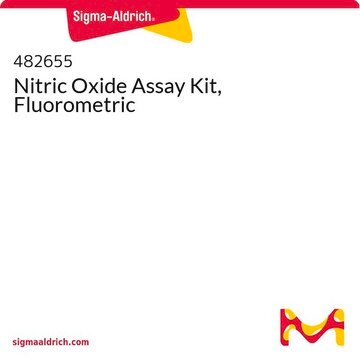We have no information on storing this product in the freezer. Yes, it is best to spin your cell culture sample down before the assay. Yes, you will need to add the reagent to your standards.
G4410
Griess reagent (modified)
Sinónimos:
Greiss, nitrite assay
About This Item
Productos recomendados
Formulario
powder
uso
10 g
Descripción general
Aplicación
- in the nitrite assay of primary spinal cord glial cells stimulated with supernatant of damaged sensory neuron (SDSN)[2]
- for measuring nitrite/nitrate oxidized from nitric oxide in stimulated chondrocytes[3]
- for measuring nitric oxide (NO) degradation in RAW264.7 macrophage cells[4]
- to measure the concentration of nitric oxide(NO) in the conditioned media from cultured macrophages (MΦs)[5]
- to determine the relative levels of NO released by BEAS-2B bronchial cells in the culture supernatants[6]
Palabra de señalización
Danger
Frases de peligro
Consejos de prudencia
Clasificaciones de peligro
Eye Dam. 1 - Skin Corr. 1
Código de clase de almacenamiento
8A - Combustible corrosive hazardous materials
Clase de riesgo para el agua (WGK)
WGK 2
Elija entre una de las versiones más recientes:
Certificados de análisis (COA)
¿No ve la versión correcta?
Si necesita una versión concreta, puede buscar un certificado específico por el número de lote.
¿Ya tiene este producto?
Encuentre la documentación para los productos que ha comprado recientemente en la Biblioteca de documentos.
Los clientes también vieron
-
1. Can the griess reagent solution be stored for longer if I keep it in the freezer? 2. Does my sample (a supernatant of cell culture media) has to be centrifuged first before I do the assay? 3. Do I add the reagent to my standard (NaNO2) as well?
1 answer-
Helpful?
-
-
if we dissolve Griess reagent 40 mg/ml in water then what will be its concentration (molarity).
1 answer-
This product is a multi-component reagent, thus a molarity is not available. When prepared according to instructions, the prepared solution will contain 0.288% (w/v) of sulfanilamide and 0.016% (w/v) naphthylethylene diaminedihydrochloride. In addition, the product also includes an unreported amount of phosphoric acid.
Helpful?
-
-
How many grams of reagent powder should be dissolved in 1 ml of distilled water?
1 answer-
This product is tested for solubility at 40 mg/mL in water. The product is intended to be reconstituted in the bottle by adding 250 ml of water. Please see the link below to review the product datasheet:
https://www.sigmaaldrich.com/deepweb/assets/sigmaaldrich/product/documents/355/046/g4410bul.pdfHelpful?
-
-
Since this is a solid, how much quantity of water it should be diluted with?
1 answer-
The 10 g quantity is packaged in a 250 mL bottle. To reconstitute, simply add 250 mL of distilled water.
Please see the link below to review the product datasheet:
https://www.sigmaaldrich.com/deepweb/assets/sigmaaldrich/product/documents/355/046/g4410bul.pdfHelpful?
-
-
how the limit of detection ?
1 answer-
According to T.P. Misko, et al., Analytical Biochemistry, 214, 11-16 (1993), this Griess Reagent, in fluorometric testing, detects to at least 10 nM nitrite. This information has not been validated.
Helpful?
-
-
What is advised for disposal if a solution is made up with H2O?
1 answer-
Please refer to the SDS for disposal information. Per section 13.1, Waste material must be disposed of in accordance with the national and loc No mixing with other waste. Handle uncleaned containers like the product. See www.retrologistik.com for processes regarding the return of chemicals and containers, or contact technical service if you have further questions. https://www.sigmaaldrich.com/sds/sigma/g4410.
Please contact your EHS team or or disposal service group, If there's none, we recommend a national disposal company such as Cleanharbors at https://www.cleanharbors.com/.
Helpful?
-
-
What is the difference between Product G4410 Griess reagent (modified), and Product 03553, Griess reagent?
1 answer-
There are many formulations of the Griess Reagent. The formulations for these products are similar; both are proprietary.
Helpful?
-
-
Will phenol red interfere with the Griess reaction Product G4410, Griess' reagent (modified)?
1 answer-
While phenol red does not interfere with the Griess reaction, it will interfere with the absorption reading taken at 540nm. It is recommended to use media without phenol red to avoid any interference in the absorption readings.
Helpful?
-
-
Is there an enzymatic method to convert nitrate to nitrite?
1 answer-
A coupled assay to convert nitrate to nitrite has been published by Grisham, M.B., et al., Quantitation of nitrate and nitrite in extracellular fluids. Methods Enzymol., 268, 237-246 (1996). For this protocol, we recommend using Product No. N7265 (Nitrate Reductase), Product No.L1378 (L-Lactic Dehydrogenase), Product No.N1630 (NADPH), Product No. P8574 (Sodium pyruvate) and Product No. F6625 (Flavin adenine dinucleotide disodium salt).
Helpful?
-
-
What is the Department of Transportation shipping information for this product?
1 answer-
Transportation information can be found in Section 14 of the product's (M)SDS.To access the shipping information for this material, use the link on the product detail page for the product.
Helpful?
-
Active Filters
Nuestro equipo de científicos tiene experiencia en todas las áreas de investigación: Ciencias de la vida, Ciencia de los materiales, Síntesis química, Cromatografía, Analítica y muchas otras.
Póngase en contacto con el Servicio técnico







![N-[(1-Methyl-1H-pyrazol-4-yl)methyl]cyclopropanamine dihydrochloride AldrichCPR](/deepweb/assets/sigmaaldrich/product/structures/125/188/0bba29e6-a365-4cc1-b8f0-8a4a66f4d626/640/0bba29e6-a365-4cc1-b8f0-8a4a66f4d626.png)

